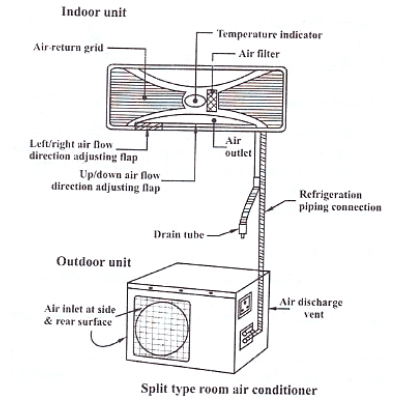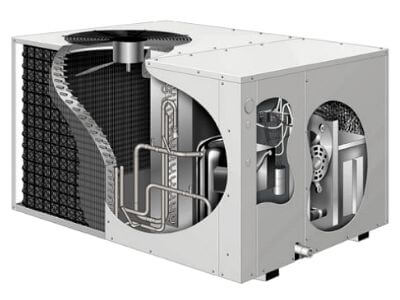Table of Contents
What is an HVAC System?
Firstly, HVAC is the shortened form for heating, ventilation, and air conditioning. It is a system that provides cooling and heating to your commercial building.
And they usually use fresh outdoor air and convert it into clean air that gets blown inside. The ventilation part of the HVAC system is the process of exchanging air within an area.
You need to know about HVAC systems because they are not the same as the air conditioner you have at home.
HVAC systems are larger and more complicated because they need to provide cooling and heating to different areas of your building.
Before you invest in an HVAC system, you need to know the entirety of it.
What is the purpose of an HVAC system?
The HVAC (Heating, Ventilation, and Air-Conditioning) system’s primary objectives are maintaining healthy indoor air quality through sufficient ventilation with filtration and giving thermal comfort.
Types of HVAC Systems
You should know there are four main types of HVAC systems you can install in your commercial building. You can also find several advantages and disadvantages of each system.
Split System
It splits between two initial units, one for cooling and another for heating. You will need to install indoor and outdoor units for them to work.

Pros:
- It comes packaged with humidifiers and purifiers
- Noiseless
- Perfect to provide a non-obtrusive look
Cons:
- Expensive
- Requires several professional HVAC contractors to install.
- Outdoor units generate more noise compared to indoor units.
Hybrid Split System
It works the same way as the typical split system, but it uses an electric hybrid heating system, mitigating energy costs.
Pros:
- It works proficiently in mild climates.
- Utilizes a traditional duct system and a thermostat.
Cons:
- Not proficient at extracting heat from the outside air.
- Does not completely reduce the carbon footprint.
Duct-Free/Mini-Split System
You will need the mini-split system if you want to install individual units in each room, ensuring maximum unit control.
Pros:
- Great for cooling and heating individual areas
- Independent control over the unit
- Perfect for commercial buildings and establishments
- Conserves energy
Cons:
- Expensive
- More noticeable than other HVAC units
- Needs constant maintenance and cleaning
- Cannot achieve air consistency
Packaged Heating and Air
It is a system that contains both the heating and air unit, and most residential properties have this system.

Pros:
- Space saver
- Easy maintenance
- Minimal indoor noise
Cons:
- Susceptible to damage
- Complicated to install on a roof
How Does an HVAC System Work?
Commercial building owners need to know how an HVAC system works because of how extensive it is.
You have condenser coils, air supply ducts, air handling units, evaporator coils, and blowers, to mention a few.
When you know how your HVAC system works, it can help provide more insight into taking care of it better.

Usually, a climate-control system has three elements:
- A source for providing warm and cool air, including a furnace and an air conditioner
- A thermostat to regulate the temperature
- A pipe or duct system to distribute air efficiently
When your building has a centralized HVAC system, both cool and warm air can pass through the same ducts and has a single thermostat that you can control.
Cooling and heating act on the principle that heat transfers from a warmer entity to a cooler one.
A heat pump is a climate control component that cools and heats the air. During colder weather and adjusting the thermostat to a warmer temperature, the furnace eats up gas, electricity, or oil that powers it and generates heat.
It then gets distributed around your building through radiators or ducts, heating panels, or registers.
And during a hotter season, a refrigerant gas within a coil in your air conditioning system gets cooled into a liquid state when you turn it on.
Warm air chills when it passes through the cooling coils and cold air gets distributed either through the same ducts where the warm air passed through or directly from the AC unit.
How Does the HVAC Transports Air Around Your Building?
You can find at least three major distribution systems to move cold and hot air around your building.
Forced Air System
It’s one system that transports temperature-controlled air through metal ducts through a blower.
Gravity System
Your HVAC technician usually installs the Gravity Systems in basements or a well-hidden space within the building.
They work on the principle that cool air sinks and hot air rises. When the air gets hot, it rises, and cool air drops down, ultimately reaching the unit.
Radiant System
HVAC technicians typically install them beneath floors, but they tend to heat implements like radiators, distributing heat around the room.
The Main Components of an HVAC System
Even if you have different brands and models, an HVAC system will still work the same way and have four main elements.
Air Conditioning Unit
The air conditioning unit utilizes electricity and has a refrigerant that chills the air. When hot air passes through the AC unit, the air gets moved outside while cool air gets blown inside.
Usually, HVAC technicians will install the AC units outside or behind surfaces within the building, including walls and ceilings.
Furnace
The furnace provides adequate heating during cooler seasons. Gas or oil provides the furnace’s power to heat air to the adequate temperature between a heat exchanger.
You can typically find furnaces in basements, specially constructed closets, or in an isolated rooms that only maintenance personnel can gain access to.
Ductwork
When the HVAC system operates, it needs ductwork to distribute cold and warm air to different parts of the building. You can find most ductwork behind ceilings.
Thermostat
Thermostat – You can say that it’s the “brain” of the entire HVAC system since it’s the one that gives out orders on what temperature to give out.
Nowadays, there are many features for thermostats to provide more comfort and function for the users. Some even have timers that automatically adjust themselves at a specific time that you set.
After installing the HVAC system on your building, install the HVAC access doors and panels to provide HVAC technicians with convenient access.
Difference Between HVAC and Air Conditioning
The air conditioning industry generally uses the term HVAC instead of AC. Manufacturers use both terms interchangeably because several AC repair services deal with both cooling and heating solutions.
- HVAC is short for heating, ventilation, and air conditioning, whereas AC stands for air conditioning.
- Generally, the term AC is used for systems that cool the air in your home. Central AC and window AC are conventional systems that are typically used.
- HVAC can combine gas furnaces, heat pumps, and air conditioning units. That means it deals with both cooling and heating. It also includes ventilation and ductwork.
I hope now you have sufficient knowledge about the HVAC system. If you find this information helpful, please share it with your friend.
Thanks!
Also, Read
Difference Between Ceramic and Vitrified Tiles
Marble vs Granite -Difference Between Marble and Granite
MDF vs Particle Board – Difference Between MDF and Particle Board
Mild Steel vs Stainless Steel – Difference Between Mild Steel and Stainless Steel